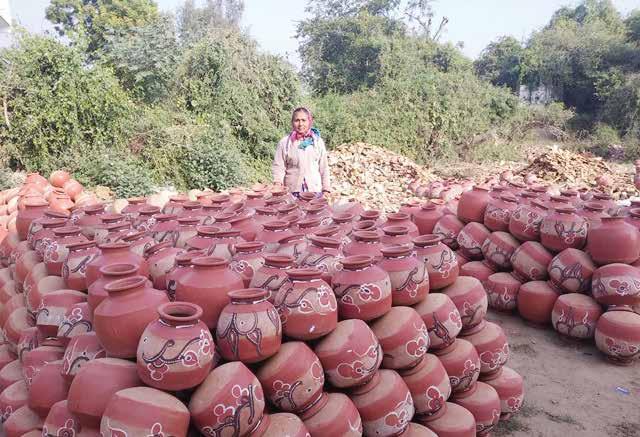
4 minute read
FIGURE 9: Silk reeling in Unnati machine
FIGURE 9: Silk reeling in Unnati machine
Seraikela Kharsawan is known for its organic cocoons and Kuchai silk fabric.
Advertisement
The Directorate of Sericulture is the principal agency responsible for promoting tussar sericulture in the state and has already established around 30 common facility centres (CFCs) in Kharsawan cluster alone and there are around 176 CFCs in the entire Kolhan Pargana. The CFCs provide necessary building infrastructure and machinery for spinning and reeling. The Jharkhand Silk Textile and Handicraft Development Corporation Ltd (JHARCRAFT) works for creating sustainable livelihoods in rural areas based on sericulture, handloom, handicrafts, and other allied activities.
Production process
In reeling process, the cocoons are ‘cooked’ in hot water to loosen their outer portion (sericin), which makes unwinding easy without breakage. Traditional chulhas using firewood are used for cocoon cooking. The cocoons after cooking are reeled in different types of machines. Many cocoons are reeled simultaneously to find an unbreakable single thread. The CFCs in the cluster are equipped with 30 ‘Unnati’ machines for reeling and 3 re-reeling machines for the production of hanks/skeins. Hanks are directly utilized as a wrap during the weaving process.
During the survey, it was found that each woman worker prepares around 1 kg of hank in a period of 6–7 days by working around 7–8 hours a day. The monthly production of the hank fibre varies from 3 kg to 6 kg depending on the skill of the worker and un-interrupted operations of reeling machines. The prepared hanks are delivered to JHARCRAFT that supplies those to various weaver clusters operating in different parts of the state.
Design of solar PV
At present, the reeling machines (Unnati) are powered by solar PV systems installed at the CFCs. The installed solar capacity is around 900 Wp for 30 Unnati machine and is already more than 10 years. It has been reported that the
systems are not performing as per expectations, which adversely affects the production. Some components including batteries and panels which are already quite old and partially damaged need immediate replacement. Thus, there is a need to replace and redesign them to improve their performance. Considering that each solar unit operates for around 8 hours a day and requires power backup of at least 6 hours to compensate for rainy or cloudy days, a solar PV system with capacity of 2.2 kWp was designed for the silk reeling unit at CFC. The proposed system is a standalone solar system and the following parameters were considered while designing the system: » Daily hours of operation are 8 hours. Electrical load of 30 Unnati machines (20 Wp each) and 6 LED luminaries (9 Wp each) for CFC building (500 ft2) were considered » The estimated cost considered the benchmark cost circulated by the MNRE that amounts INR 94 per watt (6 hours of battery back-up) applicable for 2019–20. This includes the entire cost of systems, supply, installation, and 5-year annual maintenance as per the prescribed quality and system specifications.
Proposed business model
Further, a business model, based on the field survey and consultations with local stakeholders, was developed. It is proposed to redesign the present solar systems in order to meet additional load of equipment and lighting. The current scenario will thus be changed and lead to utilization of the remaining underutilized Unnati reeling machineries owing to availability of power. Assuming only 20% additional machines are made operational by way of new procurement or upgradation of existing Unnati machines, if successfully done, the utilization factor will improve from 60% to 80%, leading to an increase in productivity by 33%. Hence, by introducing solar energy, the monthly average incremental income per woman entrepreneur would be nearly INR 1125, including the possibility of employment of additional six women in the silk reeling unit at CFC. It is likely that with an upfront equity investment of 15% and a loan amounting to 85% of the hardware cost (loan term of 3 years), a payback of less than 1 year can be achieved.
Solar potential assessment
The solar potential was calculated based on 30 CFCs that are engaged in silk reeling activity in the Kharsawan cluster. The cumulative solar potential of all the identified CFCs is estimated as 66 kWp. The existing solar systems at CFCs can also be utilized in case mechanization is introduced for replacing existing hand-operated re-reeling units (8 to 9) at the same CFC level. This would further enhance the productivity and scope for additional engagement of the women entrepreneurs.
Cluster profile
Situated in Hazaribagh district, the Bishnugarh brass and bronze utensils cluster comprises Achaljamu, Ramua, Nawadi, and Bishnugarh villages. The cluster is said to be one of the oldest in the state with brass-making skills being passed over generations for more than 100 years. According to Gram Vikas Manch (GVM), a not-for-profit organization active in the area, the population of the cluster is more than 700–800 who are engaged in brass-making products. Around 220 artisan households were found active and engaged in day-to-day operations during the survey. Out of these, around 150 households are engaged in making brass and bronze utensils, while the rest 60–70 households are engaged in the production of brass utensils only. The brass community has been re-classified based on their daily productions and the number of people engaged. Around 30–35 households are classified as large artisans whose monthly turnover is



